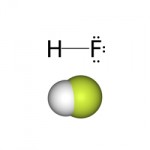KRUNAL ACID AGENCY - AHMEDABAD
- Home
- Krunal Acid Agency
- Hydrofluoroic Acid
Hydrofluoroic Acid
Hydrofluoric acid is a solution of hydrogen fluoride in water. Together with hydrogen fluoride, hydrofluoric acid is a valued source of fluorine, being the precursor to numerous pharmaceuticals, diverse polymers (e.g. Teflon), and most other synthetic materials that contain fluorine. Hydrofluoric acid is best known to the public for its ability to dissolve glass by reacting with SiO2, the major component of most glasses. This dissolution process can be described as follows:
SiO2(s) + 4HF(aq) SiF4(g) + 2H2O(l)
SiO2(s) + 6HF(aq) H2[SiF6](aq) + 2H2O(l)
Because of its high reactivity toward glass, hydrofluoric acid is typically stored in polyethylene or Teflon containers. It is also unique in its ability to dissolve many metal and semimetal oxides. It is corrosive, as explained below.
Acidity
Hydrogen fluoride dissociates in aqueous solution in a similar fashion to other common acids:
HF + H2O H3O+ + F-
When the concentration of HF approaches 100%, the acidity increases dramatically due to the following equilibrium:
2HF H+ + FHF-
The FHF- anion is stabilized by the very strong hydrogen - fluorine hydrogen bond. Hydrofluoric acid is the only one of the hydrohalic acids that is not considered a "strong acid" due to its lack of ionization.
Production
Industrially, hydrofluoric acid is produced by treatment of the mineral fluorite (CaF2) with concentrated sulfuric acid. When combined at 250°C, these two substances react to produce hydrogen fluoride according to the following chemical equation:
CaF2 + H2SO4 2HF + CaSO4
Uses
Because of its ability to dissolve metal oxides, hydrofluoric acid is used in the purification of both aluminium and uranium. It is also used to etch glass, to remove surface oxides from silicon in the semiconductor industry, as a catalyst for the alkylation of isobutane and butene (olefinic C4) in oil refineries, and to remove oxide impurities from stainless steel in a process called pickling. Dilute hydrofluoric acid is sold as a household rust stain remover. Recently it has even been used in car washes in "wheel cleaner" compounds.[1] Due to its ability to dissolve silicate compounds, hydrofluoric acid is often used to dissolve rock samples (usually powdered) prior to analysis.
Hydrofluoric acid is also used in the synthesis of many fluorine-containing organic compounds, including Teflon, fluoropolymers, perfluorocarbons, and refrigerants such as freon. Additionally, hydrofluoric acid is commonly used in refinery alkylation processes to produce a high-octane gasoline blending component called alkylate from FCCU C3 and C4 olefins and isobutane
Affinity for magnesium and calcium
Hydrofluoric acid attacks many metal oxides, forming the corresponding fluoro derivatives. In the body, hydrofluoric acid reacts with the ubiquitous biologically important ions Ca2+ and Mg2+. In some cases, exposures can lead to hypocalcemia. Thus, hydrofluoric acid exposure is often treated with calcium gluconate, a source of Ca2+ that sequesters the fluoride ions.
Safety
Hydrofluoric acid is corrosive and a contact poison. It should be handled with extreme care, beyond that accorded to other mineral acids, in part because of its low dissociation constant, which allows HF to penetrate tissue more quickly. Symptoms of exposure to hydrofluoric acid may not be immediately evident. HF interferes with nerve function and burns may not initially be painful. Accidental exposures can go unnoticed, delaying treatment and increasing the extent and seriousness of the injury. HF is known to etch bone, and since it penetrates the skin it essentially breaks the person's bones without destroying the skin. Hydrogen fluoride is released upon combustion of fluorine-containing compounds such as products containing Viton and Teflon parts. Hydrogen fluoride converts immediately to hydrofluoric acid upon contact with moisture.HF chemical burns can be treated with a water wash and 2.5% calcium gluconate gel or special rinsing solutions.









